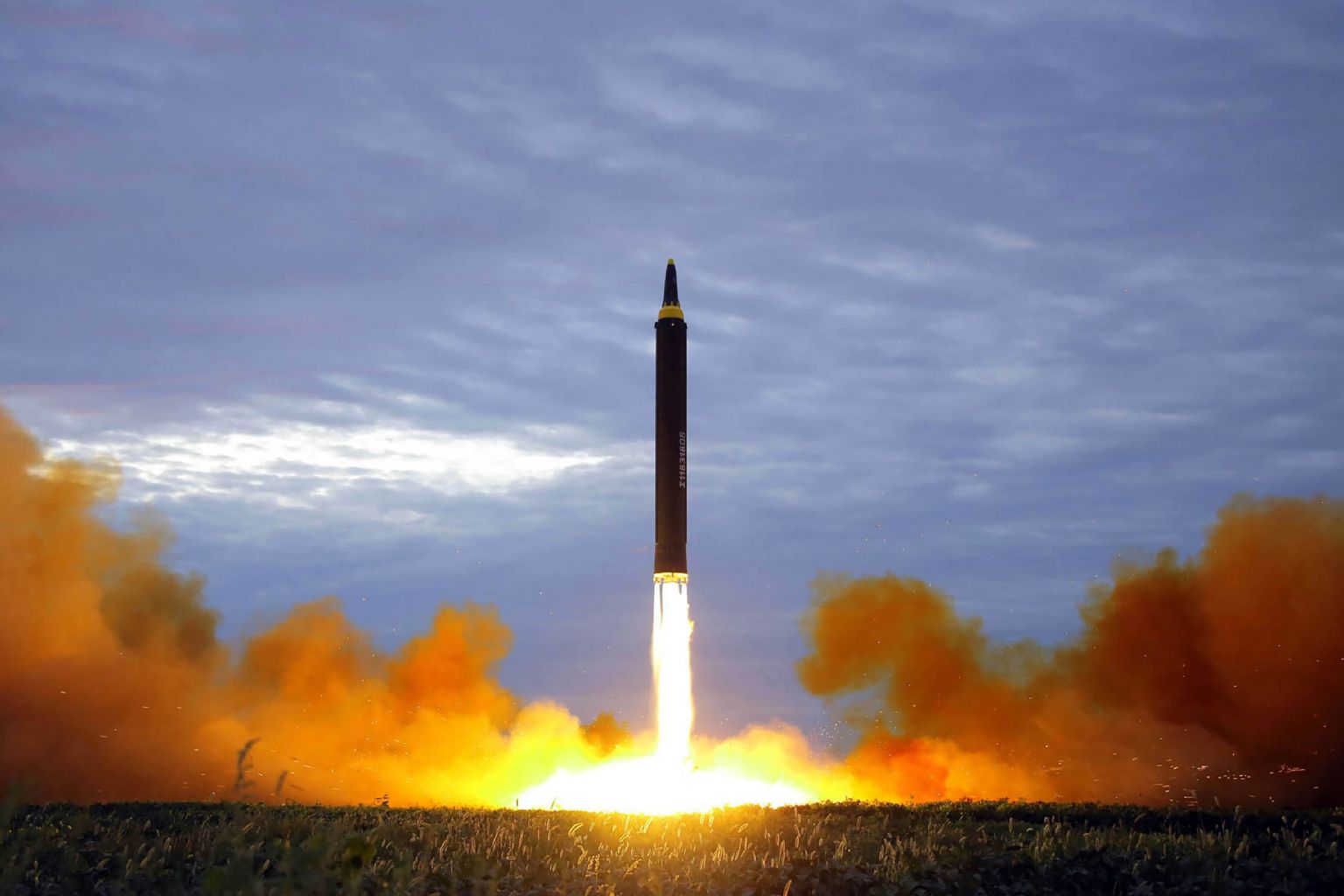By firing over Japan, North Korea avoids crossing 'red line' of directing missile at Guam
Sign up now: Get ST's newsletters delivered to your inbox

North Korea's intermediate-range strategic ballistic rocket Hwasong-12 lifting off from the launching pad at an undisclosed location near Pyongyang.
PHOTO: AFP
Follow topic:
WASHINGTON - The US military's Pacific Command has said North Korea's latest missile test in the early hours of Friday (Sept 15) did not pose a threat to North America or the US Pacific territory of Guam.
Commander Dave Benham in a statement said the Pacific Command (Pacom) detected the launch of a single North Korean intermediate range ballistic missile (IRBM) that flew over northern Japan before landing in the Pacific Ocean.
But the latest missile flew a longer distance than the previous Hwasong-12 IRBM North Korea fired over Japan late last month (Aug).
Japan's defence minister said on Friday the latest missile "is possibly of the same type as in the Aug 29 launch".
Analysts said with a flight distance of 3,700 km, the latest missile flew the longest of any North Korea missile test conducted thus far. It would have put the US island territory of Guam within reach if it had been flown in a different direction.
"The range of this test was significant since North Korea demonstrated that it could reach Guam with this missile, although the payload the missile was carrying is not known. Guam lies 3,400km from North Korea, and Pyongyang has talked about it as a target because of the presence of US forces at Anderson Air Force Base," wrote scientist David Wright on his blog.
North Korea leader Kim Jong Un had threatened to fire four Hwasong-12 missiles into the waters around Guam early last month, which President Donald Trump had warned could prompt a military response.
Some analysts say by firing the missiles over Japan, Pyongyang is showing restraint by not crossing the red line of aiming at Guam.
There was no immediate comment from President Trump. But US Defence Secretary James Mattis told reporters the missile launch over Japan "put millions of Japanese into duck and cover" before it landed in the Pacific Ocean.
"We have just got done with the calls we always make to coordinate among ourselves. Steady as she goes," he said.
Mr Mattis is on a visit to the US Strategic Command, which oversees the US' nuclear arsenal.
In a statement issued after the early morning missile launch, US Secretary of State Rex Tillerson said: "North Korea's provocative missile launch represents the second time the people of Japan, a treaty ally of the United States, have been directly threatened in recent weeks."
"These continued provocations only deepen North Korea's diplomatic and economic isolation."
The US and Japan have called a special meeting of the UN Security Council at 3pm on Friday (New York time) to confer on North Korea's latest provocation.
The UN Security Council this week imposes its strongest-ever set of sanctions on Pyongyang on Monday over its sixth and most powerful nuclear test on Sept 3 and the last missile launch on Aug 29.
For the first time since the UN Security Council imposed in 2006 the first set of sanctions against North Korea, the latest set of sanctions targeted the regime's oil supplies. The US had demanded a total ban on oil exports, but pressure from Beijing and Moscow led to weakened penalties that imposed caps on its energy supplies.
North Korean watchers say an oil embargo, which China has rejected for fear of triggering a collapse in the North, is the only card left.
Mr Tillerson again called on Beijing and Moscow to take stronger action.
"China supplies North Korea with most of its oil. Russia is the largest employer of North Korean forced labour. China and Russia must indicate their intolerance for these reckless missile launches by taking direct actions of their own."
"United Nations Security Council resolutions, including the most recent unanimous sanctions resolution, represent the floor, not the ceiling, of the actions we should take. We call on all nations to take new measures against the Kim regime."
The test over Japan - the second in less than three weeks - could propel Prime Minister Shinzo Abe closer to a more militaristic and potentially nuclear option, a US diplomat said, asking not to be named.
The diplomat added that the dilemma for the Japanese was whether to shoot the missile down.
"The Japanese would have known very soon that it was a test," the diplomat said, thus making it difficult to justify taking that step of shooting down the missile.
Mr Suga said in Tokyo that the Japanese Self-Defence Forces knew about the missile and was tracking it "immediately from the point of launch". They did not make attempt to shoot it down as Japan was not deemed to be in danger.
On the eve of the latest missile launch, North Korea threatened on Thursday to sink Japan with a nuclear weapon.
In an article this week, Dr Michael Swaine, a senior fellow at the Carnegie Endowment for International Peace, wrote that most proposals remained focused on how to get Pyongyang to give up its nuclear weapons, but "this objective appears less and less viable with every new North Korean (DPRK) missile and nuclear test".
"This suggests the need for policymakers in the United States, China, South Korea, and Japan to adopt a more realistic approach focused on deterrence, containment, and an array of crisis management measures," he wrote.

